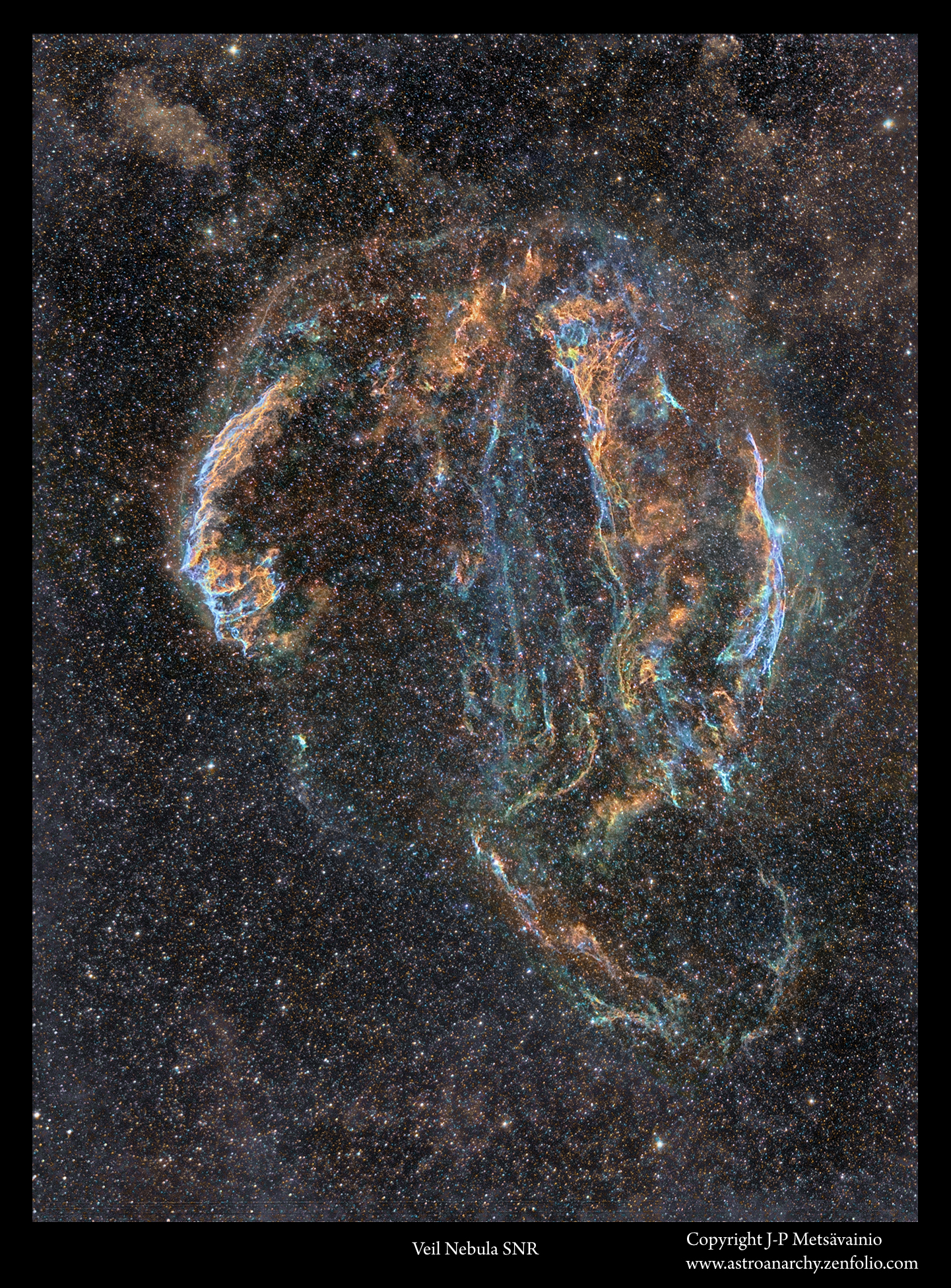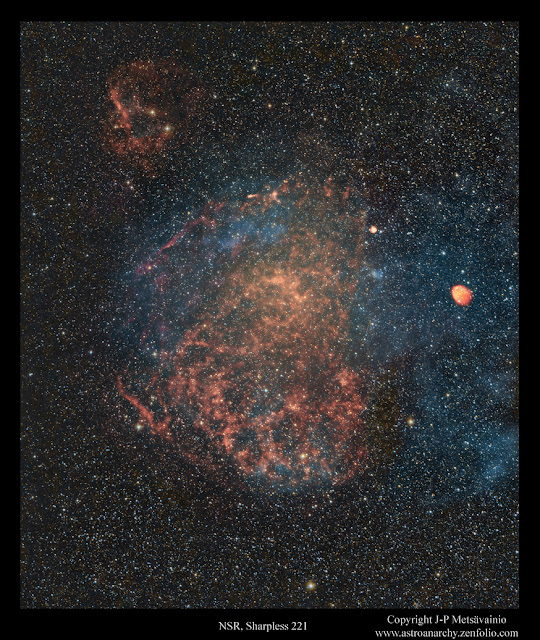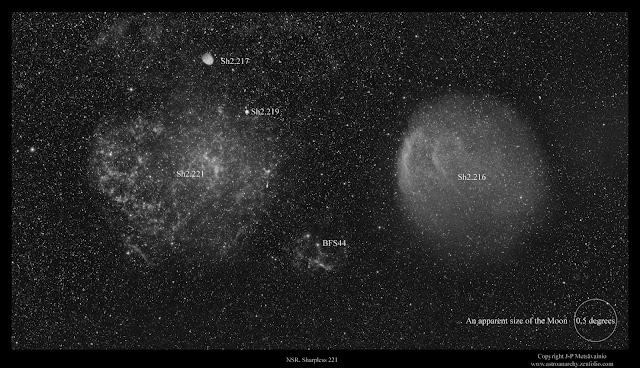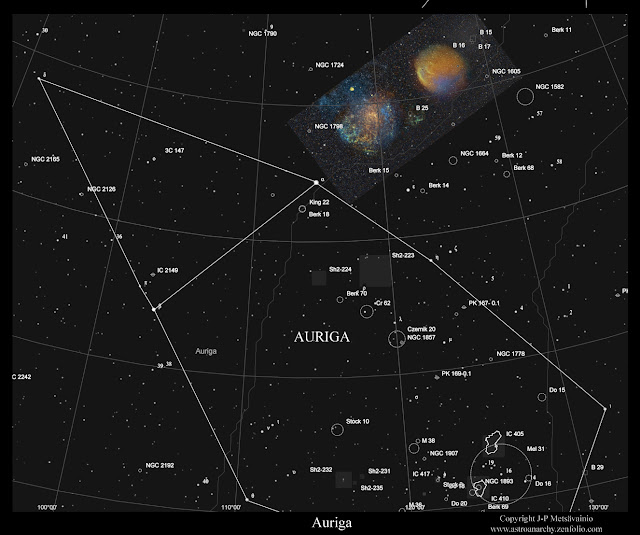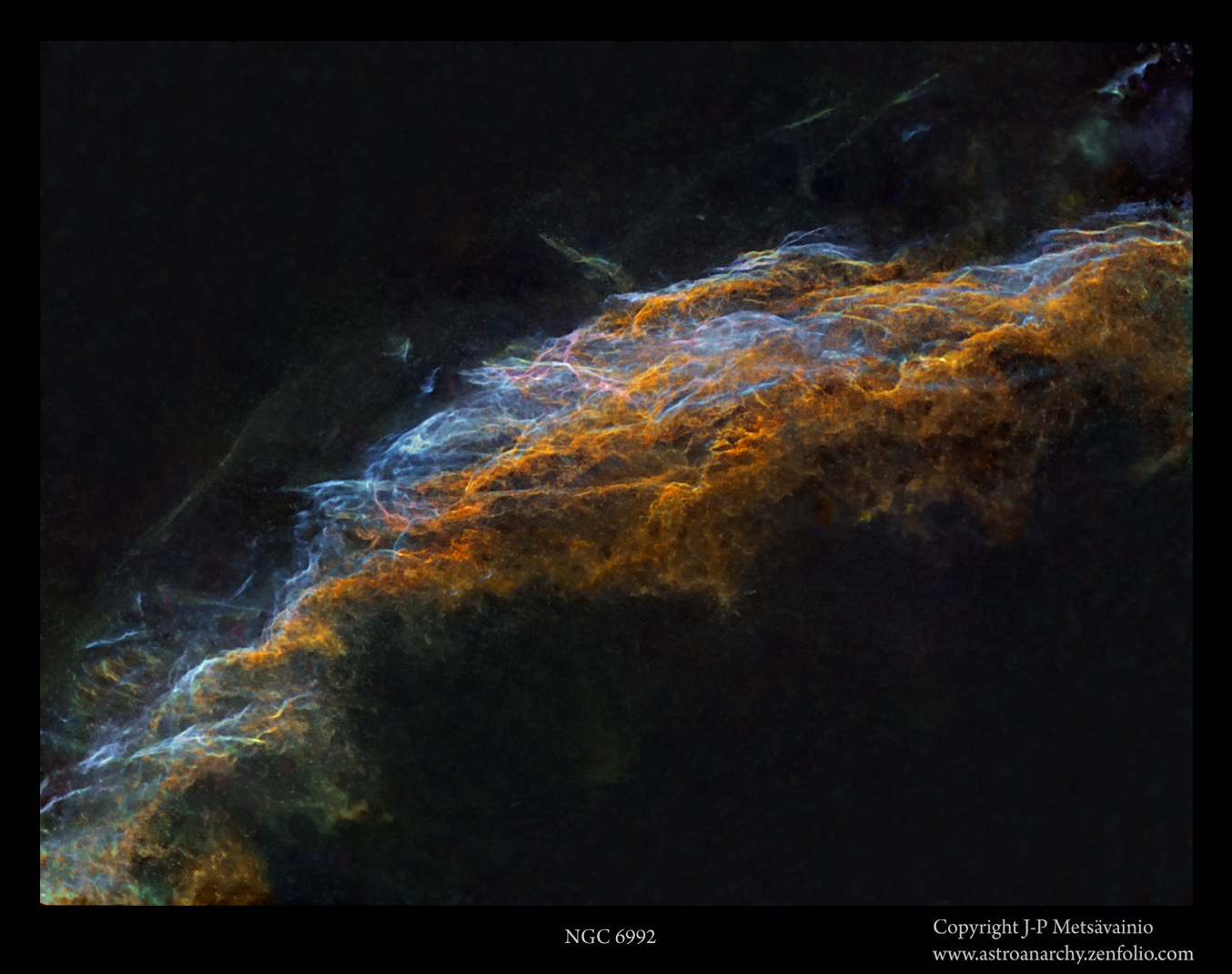COPYRIGHT, PLEASE NOTE
All the material on this website is copyrighted to J-P Metsavainio, if not otherwise stated. Any content on this website may not be reproduced without the author’s permission.
Have a visit in my portfolio
PORTFOLIO:https://astroanarchy.zenfolio.com/
Tuesday, January 28, 2014
A grande finale of the Cepheus project, mosaic of ten panels with colors
I have planned this Cepheus project for a long time. Finally I have been able to finalize it. I have done some large mosaic images of nebula rich areas in our Milky way. The ultra fast camera optics, Canon EF 200mm f1.8, it's a perfect tool for the job. It has a large, flat and sharp, image field and full open at f1.8, it collects photons very fast. The final image covers an area of about 18x10 degrees. (Full Moon has an apparent size about 0,5 degrees. 720 full Moons are needed to cover this area in the sky.)
To have a color image, each of the panels have been shot three times. This narrowband image is shot with QHY9 (a cooled astronomical camera), Canon EF 200mm f1.8 camera optics full open, Baader Planetarium Narrowband filter set for an emission of ionized elements, Hydrogen, Oxygen and Sulfur. (H-alpha, O-III and S-III) The dimensions of the final mosaic image are 12000 x 6500 pixels.
Emission Nebulae in constellation Cepheus
Mosaic image of ten individual panels, total exposures 92h.
Click for a very large image, 3000 pixels wide and 7MB.
Buy a real photographic print from HERE
About 1:1 detail from the image above
Click for a full size photo
Lots of stars out there.
Cepheus Nebulae in visual spectrum
Composed from the narrowband channels
Image is in Natural color palette from the emission of ionized elements,
R=Hydrogen + Sulfur, G=Oxygen and B=Oxygen + Hydrogen.
Buy a real photographic print from HERE
B&W image with an emission of Hydrogen alpha only
Image of light, emitted by an ionized Hydrogen.
Buy a real photographic print from HERE
A labeled image and orientation
Some main objects are labeled here
An orientation in constellation Cepheus. The mosaic image covers an area of ~18x10 dgrees.
Technical details
I have used lots of an older material for this image. I have shot this area for years, with a different instruments, with different focal lengths and apertures. The total exposure time for the final mosaic image is calculated by adding the exposures for the actual mosaic to the exposures for sub-images used.
List of the sub-images used for a large, 10 panels, mosaic of Cepheus
The first part of the mosaic, four panels: http://astroanarchy.blogspot.fi/2013/12/a-start-of-new-project-cepheus-mosaic.html
Sharpless 132, a wide field shot: http://astroanarchy.blogspot.fi/2011/02/sh2-132-project-finalized.html
Sharpless 132, a closeup: http://astroanarchy.blogspot.fi/2013/10/the-second-image-of-autumn-season-2013.html
Cave Nebula, a wide field shot: http://astroanarchy.blogspot.fi/2011/01/sh2-155-cave-nebula-reprocessed.html
Cave Nebula, a closeup: http://astroanarchy.blogspot.fi/2012/12/the-cave-nebula_9.html
Processing work flow
Image acquisition, MaxiDL v5.07.
Stacked and calibrated in CCDStack2.
Deconvolution with a CCDStack2 Positive Constraint, 33 iterations, added at 50% weight
An extra background normalization in CCDStack for a mosaic match.
Color combine for each panel in PS CS3
Panel composition in PS CS3
Levels, curves and the final color matching in PS CS3.
Imaging optics used for the mosaic image
Meade LX200 GPS 12" reduced to f5
Tokina AT-X 300mm f2.8
Canon EF 200mm f1.8
Cameras and filters
Imaging camera QHY 9, with a QHY filter wheel
Guider camera, Lodetsar
Active optics unit SXV-AO with Meade LX200 12" telescope
Baader Filter set, 7nm H-aplha, 8nm S-II and 8.5nm O-III
Total exposures used for a mosaic image
H-alpha 160 x 1200s Bin 1x1
O-III 66 x 1200s Bin 1x1
S-II 50 x 1200s Bin 1x1
Total exposures 276 x 1200s = 92h
Saturday, January 25, 2014
A zoom in series of the Cave Nebula, Sh2-155
Now and then I have published some zoom in series of various objects imaged by me.
The purpose is to show the apparent scale in the sky. Beside that, this series shows nicely the fractal nature of our universe. Series are possible to make, since I have shot many objects with various focal lengths.
Like this one is shot with 200mm, 300mm and ~2000mm focal lengths
The Cave Nebula, a study about the scale in the sky
Note. A circle, size of the Moon, in the images as a scale. (An apparent scale of the Moon is 0,5 degrees, or 30 arc minutes.)
Note. A circle, size of the Moon, in the images as a scale. (An apparent scale of the Moon is 0,5 degrees, or 30 arc minutes.)
All images are in Mapped colors from the emission of ionized elements,
R=Sulfur, G=Hydrogen and B=Oxygen.
Friday, January 24, 2014
A new header image, Oxygen emission of the Eastern Veil nebula
I have added a new header photo. It shows a small portion of the Veil Nebula supernova remnant in Cygnus. Image shows the Eastern veil but only in light emitted by ionized Oxygen, O-III.
I have published this image at January 7 this year. A blog post about it can be seen HERE.
An emission of ionized Oxygen in Eastern Veil Nebula.
The Veil nebula SNR
This is an image about the whole Veil Nebula. A blog post about this image can be seen HERE
A detail image above can be seen at left edge of the image bellow. Click for a large image.
Thursday, January 23, 2014
A supernova remnant in Cygnus (Not a Veil nebula) reprocessed
I found six hours of unused H-a data, for this SNR, from my hard drive! Now the dim background emission of an ionized hydrogen is in balance with O-III emission of supernova remnant. The overall look and feel of the image is much natural, I think.
This is a rarely imaged target. I haven't been able to find an other color image of it, showing the whole supernova remnant. This is also one of the most difficult targets, I have ever shot. Due to a very dense star field, large angular dimension and a very diffused structure this is even more difficult target, than a Simeis 147 supernova remnant in Taurus. Total exposure time of 38h was needed to have this image.
This is a rarely imaged target. I haven't been able to find an other color image of it, showing the whole supernova remnant. This is also one of the most difficult targets, I have ever shot. Due to a very dense star field, large angular dimension and a very diffused structure this is even more difficult target, than a Simeis 147 supernova remnant in Taurus. Total exposure time of 38h was needed to have this image.
G65.3+5.7 SNR has about the same angular dimensions, than brighter and more famous remnant in Cygnus, the Veil Nebula. The angular dimensions are about 3x4 degrees.
NOTE, this image is updated at 20.01.2014. There is now a better H-a channel and the background is practically full of ionized Hydrogen, H-alpha.
NOTE, this image is updated at 20.01.2014. There is now a better H-a channel and the background is practically full of ionized Hydrogen, H-alpha.
G65.3+5.7 SNR, reprocessed with extra H-a data
A supernova remnant in constellation CygnusA bicolor image of the supernova remnant. An ionized Hydrogen emission (H-alpha) can be seen as Red and an ionized Oxygen emission (O-III) as Blue. Buy a photographic print from HERE
So many stars...
A closeup from the full resolution image, click to see it at maximum size.
Orientation
Processing work flow:
Image acquisition, MaxiDL v5.07.
Stacked and calibrated in CCDStack2.
Deconvolution with a CCDStack2 Positive Constraint, 33 iterations, added at 33% weight
Levels, curves and color combine in PS CS3.
Optics, Canon EF 200mm camera lens at f1.8
Camera, QHY9
Guiding, Meade LX200 GPS 12" and a Lodestar guider
Image Scale, ~5 arcseconds/pixel
Tuesday, January 21, 2014
Sh2-221, a supernova remnant in Auriga
I think, this is the first three band color image, showing the whole Sh2-221, in the World.
This was one of the most difficult targets I have done so far. Supernova remnant Sh2-221, SNR G160.4+02.8, HB9, locates in constellation Auriga and has an angular dimensions about 2.5 x over 3 degrees. I never seen or red about the extended ionized Oxygen area, visible in my image as blue.
About 33h of exposures with extremely fast camera optics, Canon EF 200mm f1.8 @f1.8, was needed for this image. Total exposure time for the mosaic image, with a Planetary Nebula Sh2-216, is about 58h.
This could be the very first narrow band color image in the world out of this target. Generally, there are very few images of it. I couldn't find an other image showing the whole remnant nor other channels, than H-a.
I have shot this area before but at the time part of the Sh2-221 was missing. This new image of mine is much more accurate and deep.
I have shot this area before but at the time part of the Sh2-221 was missing. This new image of mine is much more accurate and deep.
Sh2-221, Sh2-221, SNR
A supernova remnant in Auriga, Ra 04 43 21 Dec 46 42 06Mapped colors
Mapped colors from the emission of ionized elements,
R=Sulfur, G=Hydrogen and B=Oxygen.
Buy a photographic print from HERE
Visual spectrum
Image is in Natural color palette from the emission of ionized elements,
The Supernova remnant Sh2-221 (SNR G160.4+02.8, HB9) locates in constellation Auriga, about one degree West from Capella. (Doesn't show in my image) The distance from the Earth, 2600 light years, is determined recently at 2007. This object was recognized as a supernova remnant back at seventies.
A two panel mosaic image of Sh-221 and Sh2-216
Two ways to end a life of the star in a same seven degrees field of view!
Just next to Sh2-221 locates a closest known planetary nebula, Sh2-216. This is also a very rarely images target, due to its low surface brightness and large angular dimension. This mosaic image covers over seven degrees of sky vertically. (The Moon has an apparent dimension of 0.5 degrees.) Mosaic is made out of my new data of Sh2-221 and an older material of Sh2-216. Some new exposures was taken for the Sh2-216 to match the background for a mosaic image.
Image shows two different ways to end a life of the star. At left, as a Supernova and at right as a Planetary Nebula. (Massive stars will go to a Supernova, after burning out all of the Hydrogen. There will be a Neutron star or a Black Hole left behind. Lighter stars, as our Sun, will turn to a Planetary Nebula, after ran out of Hydrogen. There is a core of the star left behind, it's called a White Dwarf and it will cool down gradually. )
Mapped colors
Mapped colors from the emission of ionized elements,
R=Sulfur, G=Hydrogen and B=Oxygen.
Buy a photographic print from HERE
Visual spectrum
Image is in Natural color palette from the emission of ionized elements,
R=Hydrogen + Sulfur, G=Oxygen and B=Oxygen + Hydrogen.
Buy a photographic print from HERE
Buy a photographic print from HERE
A labeled image
Note. A circle, size of the Moon, is marked as a scale. Both objects are very large targets, as can be seen.
Orientation in Auriga
Technical details
Processing work flow:
Image acquisition, MaxiDL v5.07.
Stacked and calibrated in CCDStack2.
Deconvolution with a CCDStack2 Positive Constraint, 33 iterations, added at 50% weight
Levels, curves and color combine in PS CS3.
Optics, Canon EF 200mm camera lens at f1.8
Camera, QHY9 with the Baader narrow band filter set, H-a, S-II and O-III
Guiding, Meade LX200 GPS 12" and a Lodestar guider
Image Scale, ~5 arcseconds/pixel
Exposures for the Sh2-221 SNR
H-alpha: 51 x 1200s = 17h
O-III: 21 x 1200s = 7h
S-III: 27 x 1200s = 9h
Exposures for the Sh2-216 Planetary Nebula
H-alpha: 30 x 1200s = 10h
O-III: 18 x 1200s = 6h
S-III: 27 x 1200s = 9h
Total exposure time 58h
Animation of the narrow band channels
In this animation each color channel of Sh2-221 is shown separately. A special technique of mine, Tone Mapping, was used to dig out some extremely dim data.
A set of individual 20 min. exposures for used channels.
Note.
Images are calibrated with Bias corrected Flats and Darks. A very strong none linear stretching is performed to the images. A hint of the Planetary Nebula Sh2-216 can be seen at most right.
H-alpha, the light emitted by an ionized Hydrogen
A single 20 min. exposure of H-alpha
S-II, the light emitted by an ionized Sulfur
A single 20 min. exposure of S-II
O-III, the light emitted by an ionized Oxygen
A single 20 min. exposure of O-III
Saturday, January 11, 2014
An experimental 3D-studies of Melotte 15 in IC 1805, the Heart Nebula
Images are for two different viewing methods, the first is for the Parallel Vision method and the second one for the Cross Vision method. Viewing instructions can be seen HERE.
Anaglyph versions , for the Red/Cyan eyeglasses, can be found from my portfolio HERE.
NOTE! This is a personal vision about volumes and shapes, based on some known facts and an artistic impression.
3D-freeview stereo pairs of the Melotte 15
An emission nebula in heart of the Heart nebula, IC 1805
Parallel Vision
( A Cross Vision versions are just after this set.)
My original photo of Melotte 15, with technical details, can be found from HERE.
A wide field view
The Melotte 15 can be seen at center of the Heart Nebula at bottom middle.
Cross Vision
A wide field view
The Melotte 15 can be seen at center of the Heart Nebula at bottom middle.
Labels:
stereo images
Thursday, January 9, 2014
soul Nebula, an experimental 3D-study
Images are for two different viewing methods, the first is for the Parallel Vision method and the second one for the Cross Vision method. Viewing instructions can be seen HERE.
Anaglyph versions , for the Red/Cyan eyeglasses, can be found from my portfolio HERE.
NOTE! This is a personal vision about volumes and shapes, based on some known facts and an artistic impression.
3D-freeview stereo pairs of the Soul Nebula, IC 1805
An emission nebula in Cassiopeia
Parallel Vision
( A Cross Vision versions just after this set.)
Soul Nebula
Soul nebula detail 1
Soul nebula detail 1
Cross Vision
Soul Nebula
Soul Nebula detail 1
Soul Nebula detail 2
My original images, with technical details
http://astroanarchy.blogspot.fi/2012/12/soul-nebula-up-close-personal.html
Labels:
stereo images
Tuesday, January 7, 2014
NGC 6992, Eastern Veil, an ionized Oxygen only
Eastern Veil was my opening image of the Autumn season 2013.
I just made a new image out of it. This photo shows only an emission of the ionized Oxygen.
NGC 6992
A portion of the Eastern Veil in Oxygen light
An emission of ionized Oxygen in Eastern Veil Nebula.
An original image shows three emission lines, H-alpha, Sulfur II and Oxygen III
Link to an original blog post with the technical details HERE.
Three emission lines as an animation
I just made a new image out of it. This photo shows only an emission of the ionized Oxygen.
NGC 6992
A portion of the Eastern Veil in Oxygen light
An original image shows three emission lines, H-alpha, Sulfur II and Oxygen III
Link to an original blog post with the technical details HERE.
Three emission lines as an animation
Saturday, January 4, 2014
Astro Anarchy gets published
My works are selected as a public content for a pedestrian zone in my home town Oulu, Finland.
There is a very large display unit at the end of the zone, 5.12 x 3.2 meters (over 16 x 10 feet). Four different sets of my astronomical photographs and animations are running there as a slide show, January 2014.
I have had my images in the same public screen before, January at last year. This time there is not only normal images but also my experimental 3D-work. The show will run at every 15-25 minutes or so and last about three minutes at the time.
I have had my images in the same public screen before, January at last year. This time there is not only normal images but also my experimental 3D-work. The show will run at every 15-25 minutes or so and last about three minutes at the time.
The public show of my experimental astronomical 2D to 3D converted images, January 2014
An animated 3D-model of the Bubble Nebula in a very large public screen
This is one of the movies, visible in a public screen
A low resolution sample, click to start. Duration about three minutes.
All my astronomical photographs can be found from my PORTFOLIO.
All my astronomical photographs can be found from my PORTFOLIO.
Labels:
publications
Friday, January 3, 2014
An experimental 3D-studie, Sharpless 132, Sh2-132
Images are for two different viewing methods, the first is for the Parallel Vision method and the second one for the Cross Vision method. Viewing instructions can be seen HERE.
NOTE! This is a personal vision about volumes and shapes, based on some known facts and an artistic impression.
3D-freeview stereopairs of Sh2-132
An emission nebula in Cepheus
Parallel Vision
Cross Vision
An original 2D-image of mine, used for the 3D-conversion above
A blog post about this image, with the technical details, can be found HERE
Buy a photographic print from HERE
PS.
Please, let me know, if you are able to see 3D-stereo pairs, by leaving a comment.
If there are no viewers, I'll stop posting my 3D-experiments, since they can be kind of confusing.
All my 3D-experiments can be found from my Portfolio
Labels:
stereo images
Wednesday, January 1, 2014
All of my images from the year 2013
This is a poster format presentation out of my images from the year 2013. There are couple of my favorites, like a two panel mosaic of Melotte 15 area in IC 1805, the Heart Nebula, at bottom middle. An other favorite of mine is a rarely imaged supernova remnant in constellation Cygnus, the G65.3+5.7SNR at bottom right.
Two optical configurations was used, Meade LX200 12" and a Canon EF 200mm f1.8 camera lens.
Two optical configurations was used, Meade LX200 12" and a Canon EF 200mm f1.8 camera lens.
Results of my passion from the year 2013
Click for a large image, note. 5.3MB and 2100x2500 pixels.
You can buy a real museum quality photographic print from all of my images.
Please, use a online shop in my portfolio, or contact directly to me.
PORTFOLIO
CONTACT
Labels:
Narrowband color images,
nebula
Subscribe to:
Posts (Atom)










